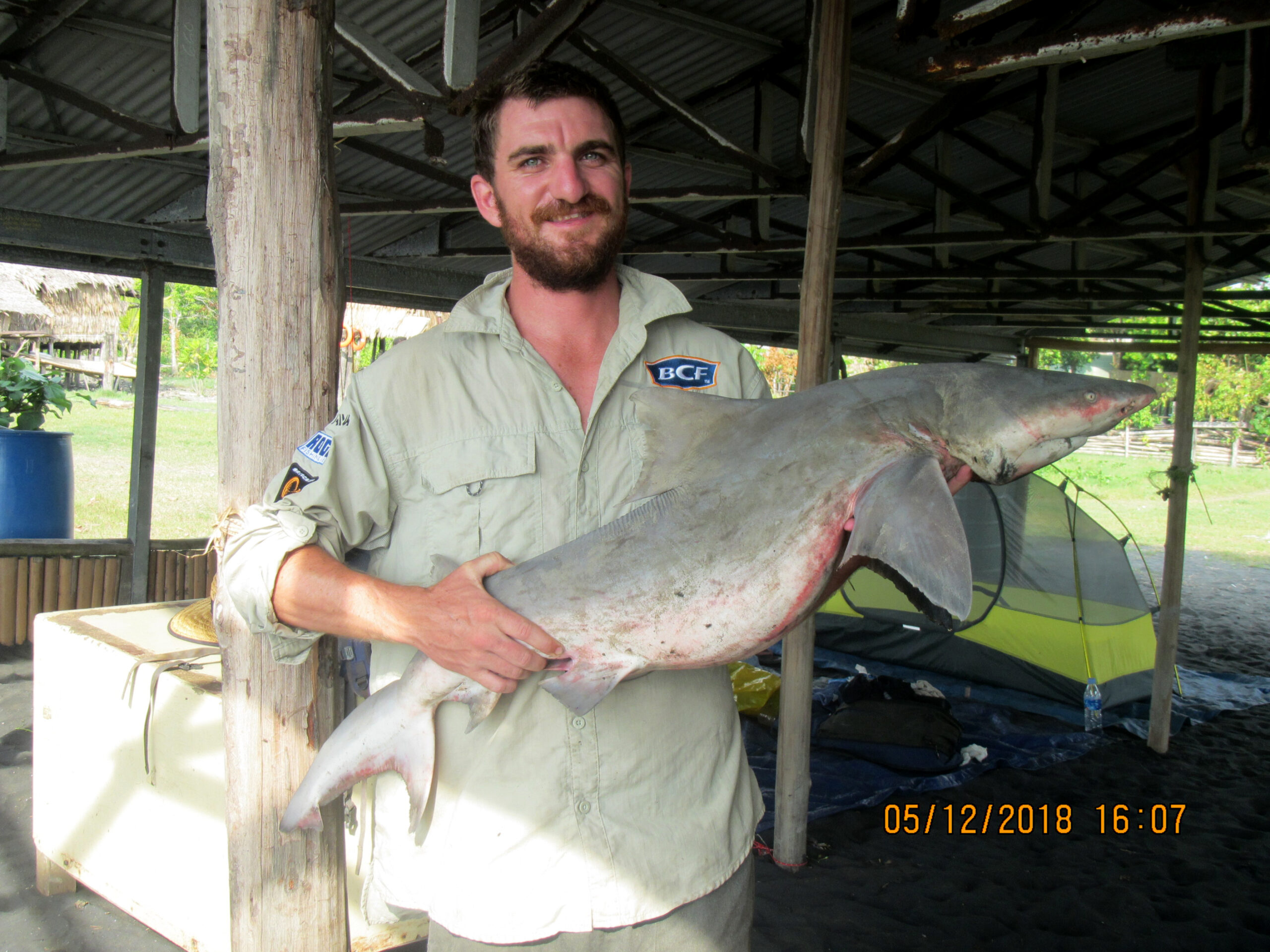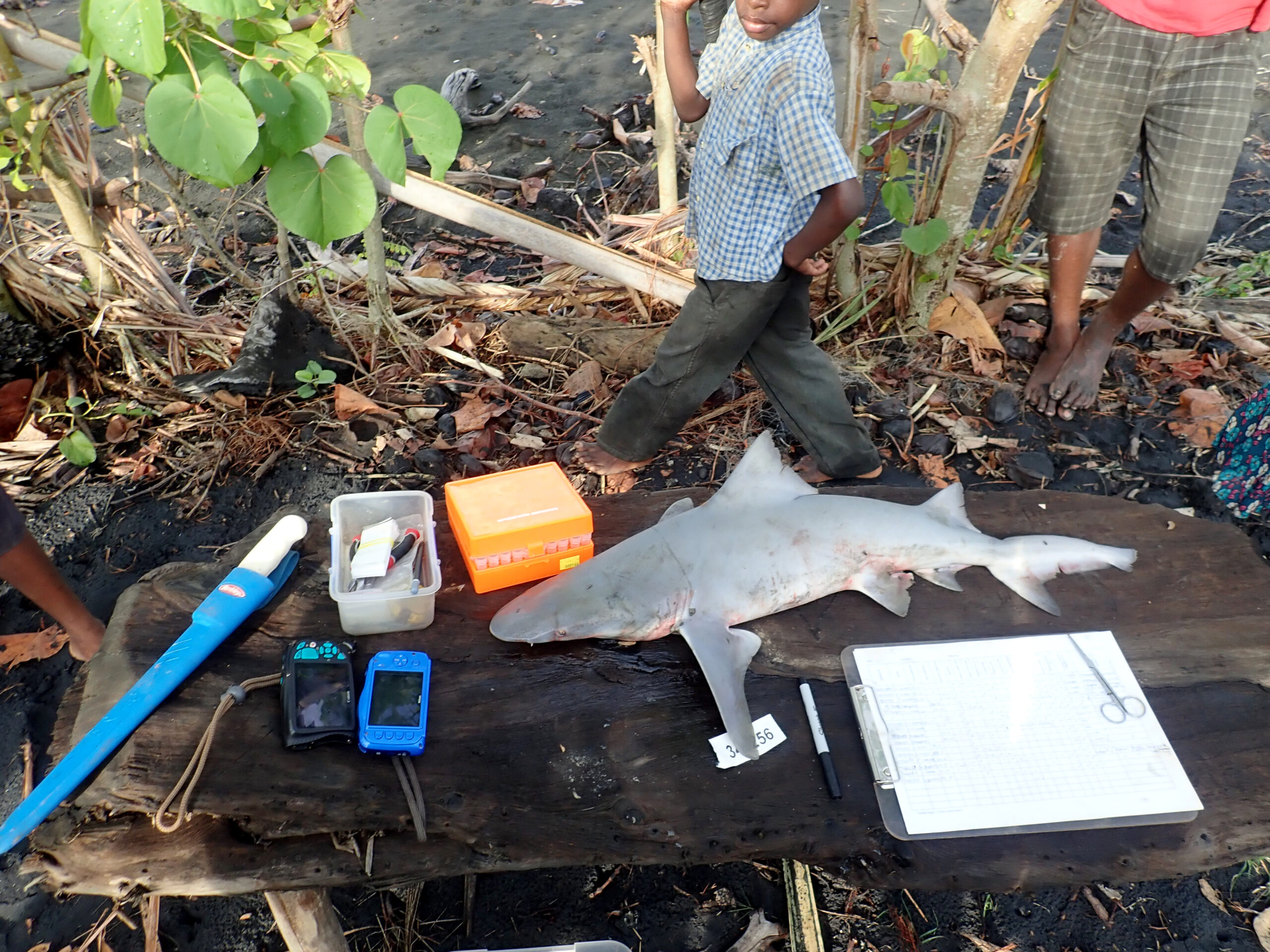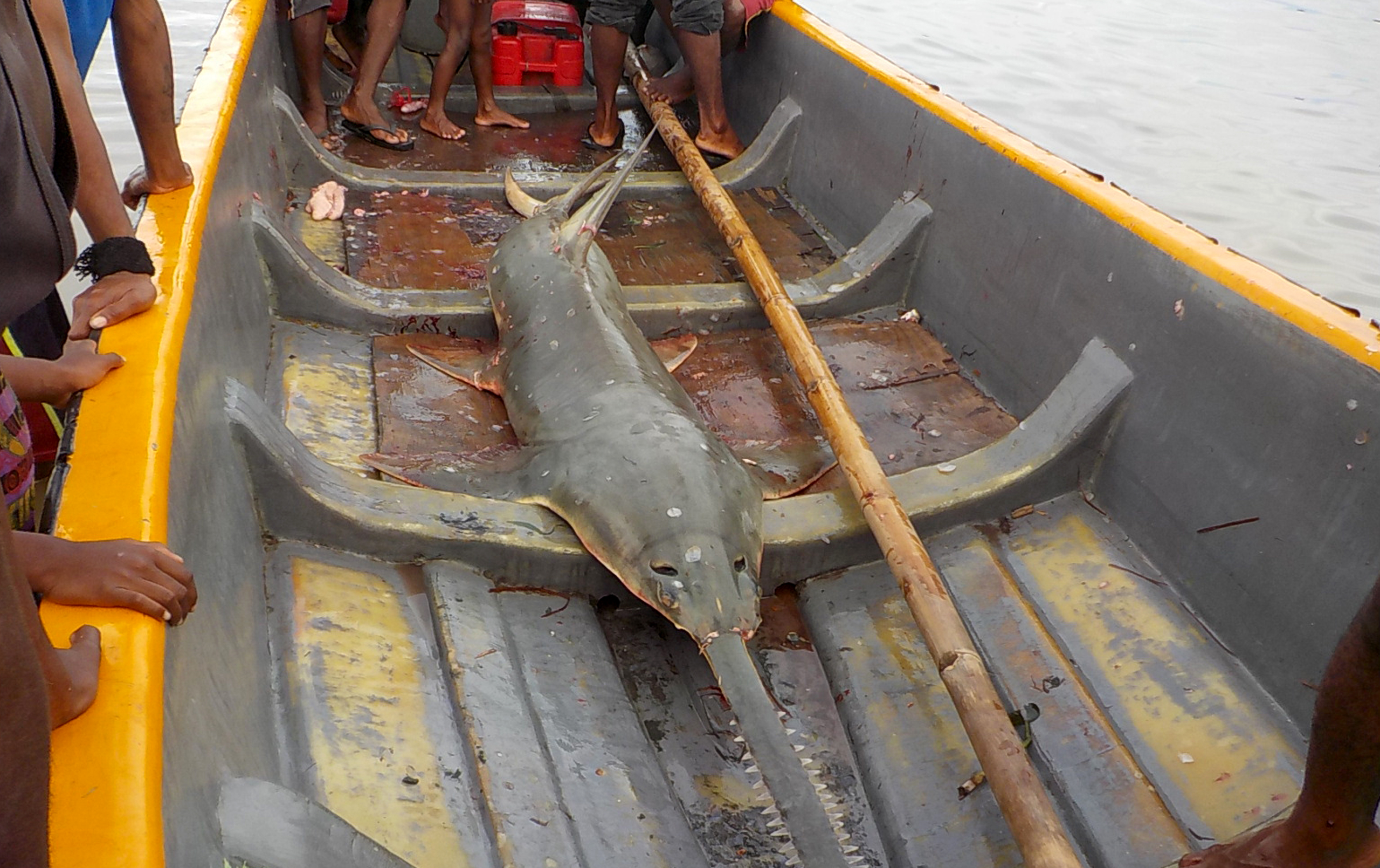Award winning research tracing habits and habitats of PNG’s river sharks and rays
Researcher wins award for best paper on finding new ways to trace the habits and habitats of Papua New Guinea’s river sharks and rays
Mosquito-riddled floodplains, crocodile-infested waters and dense rainforest make remote Papua New Guinea one of the planet’s most challenging research frontiers. And yet a challenge is exactly the mantle taken up by Save Our Seas Foundation (SOSF) project leader Michael Grant. Michael has been awarded the Huntingford Medal by the International Society for Fish Biology for his paper ‘Elemental analysis of vertebrae discerns diadromous movements of threatened non-marine elasmobranchs’, which was published in the Journal of Fish Biology in 2023.
In his paper, Michael assesses a unique technique – the use of isotopic traces of certain elements laid down in shark vertebrae – to understand which habitats the sharks and rays of remote Papua New Guinea are frequenting. For most species, a host of research methods are used to obtain a ‘snapshot in time’ of their life histories, but Michael and his co-authors want to help piece together the entire life history of some of the world’s most threatened animals. Their means of doing so needs to be viable and repeatable in a far-flung region where culture and conservation collide and field conditions are undeniably tough. The Huntingford Medal, awarded for the best research paper published in the Journal of Fish Biology by an early-career researcher, recognises their significant efforts. The award will be presented at the Fisheries Society of the British Isles (FSBI) conference in Bilbao, Spain, between 15 and 19 July.

Michael Grant holding a Glyphis glyphis (Speartooth Shark) caught in a gillnet set overnight in the Kikori River Delta, Goare Village. Photo © Yolarnie Amepou
River sharks, remotes reaches – and a researcher fascinated with both
‘We actually don’t know a whole lot about sharks and rays and rivers,’ says Michael, whose fascination with the fish that frequent the freshwater reaches of Australia started when he was growing up. ‘I became interested in rivers and the sharks that live in them mainly from fishing with my dad. We did a lot of fishing in the Clarence River in eastern Australia and bull sharks were pretty regular bycatch.’ He has gone on to run an SOSF-funded project that harnesses local ecological knowledge from fishers and villagers in remote Papua New Guinea, piecing together a picture of the region’s sharks and rays.
‘Things mainly happened by chance in terms of me winding up researching rivers in Papua New Guinea,’ he explains. ‘Dr William White had a large project funded to follow up on some preliminary sawfish findings he had made when looking into the country’s coastal fin trade and I just happened to be wrapping up my Honours and looking for a PhD at the time. Very soon into what became my PhD work, it became clear that we don’t know a whole lot about sharks and rays and rivers, aside from the bull shark and largetooth sawfish. From there, I guess I saw an opportunity to specialise in a small corner of shark and ray research and that was that. Non-marine sharks and rays have now been my primary research focus for about seven years.’
Turama River head waters and surrounding rain forest in the Gulf Province of Papua New Guinea. Photo © Michael Grant
Keeping an ear out? Ear bones can tell us about fish ages, stages and travels
Michael’s work opens up new avenues in the field of shark and ray research, and he has taken inspiration from other reaches of the research world. ‘I was inspired by some research I was reading on diadromy (migrating between salt water and fresh water) in eels while I was pulling my PhD proposal together. Teleost fishes (including eels) have ear bones called otoliths. As the animal grows, these otoliths record “bands”, much like tree trunks have rings. Bands laid in summer tend to be larger and dense, as the water is warmer and the fish are inclined to eat more and grow more. Bands laid in winter tend to be thin and less dense, as growth usually slows in these colder months. This is how we age fish, by counting how many summers and winters an individual has been alive, based on the alternating pattern of large, dense (summer) and thin, less dense (winter) bands in their otoliths.’
So scientists know how to age fish much like they do trees. But Michael is interested in where different species spend their time during different life stages. How do we tell where that fish was at a certain age? ‘Some researchers have then taken this further,’ Michael explains. ‘Material that is deposited in the bands of otoliths as the animal grows is mainly calcium. But there are also trace amounts of other elements. One of the major ways other elements get into the otolith is through diffusion. They enter the blood via the gills from the water the animal was living in and occasionally end up being deposited in the otolith. Once deposited, these elements are trapped and subsequently buried under the next layer forming. As researchers, we can examine the trace amounts of elements other than calcium trapped in the bands of otoliths to learn about the type of environment the fish was living in when that band was forming.’
Of course, Michael’s primary interest lies not in the ocean where we’d typically search for sharks, but in fresh water. That means he’d need to look for elements that can help distinguish freshwater habitats from saltwater ones. ‘We know,’ he says, ‘that fresh water is typically high in barium and marine water is low in barium. So if we examine a band within an otolith and find that it has lots of barium, we can infer that the fish was in fresh water at that time. Similarly, if we examine a band and find low amounts of barium, but high strontium or lithium (two elements typically in greater concentration in marine environments compared to freshwater ones), then we can infer the animal was in salt water at the time that band was forming. In this sense, we can use otoliths to age fish and to reconstruct their patterns of habitat use.’

Glyphis garricki (northern river shark) caught at Goare Village, Kikori River Delta in Papua New Guinea.
It’s elemental: can we use vertebrae to confirm where sharks and rays are swimming?
But teleost fish have bones, whereas sharks and rays have skeletons made of cartilage. This presents a conundrum to researchers – or does it? ‘Although our cartilaginous shark and ray friends do not have otoliths, they do have vertebrae, and these vertebrae deposit bands like otoliths do.’ Michael borrowed the idea routinely used in the teleost fish sciences and tested whether it could work for the under-researched sharks and rays in the rivers of remote Papua New Guinea.
‘The main question of this work was whether we can use the same elements commonly examined in teleost fish otoliths to trace the movement between environments of sharks and rays by looking at their vertebrae. This had been done before, but the previous studies had limited sample sizes of usually one species and often only considered either strontium or barium without investigating the inverse relationship of these elements. Here, we set out to test a range of species, and from a range of locations, to determine whether barium, lithium and strontium were effective for environmental tracing.’ And, as Michael puts it, ‘Everything worked out as would have been expected.’
The researchers focused on two river sharks (the northern river shark and the speartooth shark) and two species of sawfish (largetooth sawfish and narrow sawfish) in three broad regions: northern and southern Papua New Guinea and northern Australia. They also included samples from the bull shark, silky shark, grey reef shark and Australian blackspot shark to help interpret the environmental elemental signatures. ‘Pelagic and inshore marine species showed no indication of freshwater influence, whereas our juvenile largetooth sawfish had high concentrations of trace elements associated with fresh water. River sharks were intermediate, suggesting that they were probably sitting in the estuary between freshwater and marine environments. These inferences made from the vertebral chemistry match what we see in reality… Silky sharks occur in deep and chemically stable pelagic waters, juvenile largetooth sawfish occur in fresh water, and river sharks have almost exclusively only ever been seen in estuaries.’
Michael is positive about the outcomes of this assessment. ‘This study adds to a growing evidence base that elements incorporated into vertebrae can be used as environmental tracers,’ he confirms. ‘Although our present study focused on diadromous movements, other applications can include things useful to management like understanding stock structure, migration patterns and recruitment from nursery areas. Isotopic signatures in vertebrae also have potential to be useful indicators of trophic ecology (where do sharks and rays fit in the food web?). I think the holy grail of this elemental work would be to develop a method to validate the temporal periodicity of band pair formation. Some of our next research is to try and identify seasonally occurring isotopes and then try to detect these in vertebrae.’
Catch observed at Katatai Village is laid out for documentation. Photo © Dick Jogo
Endangered estuaries: are sharks more vulnerable where rivers meet the sea?
Somewhere between the river and the sea, estuaries are the critical interface between not only the marine and freshwater habitats, but the species that use both. They also happen to be known as important nursery areas for many marine species and, in most cases around the world, they are highly threatened (and usually highly modified and utilised) environments. ‘The most surprising result was that our data indicated that gestating sawfish are occurring mainly within the estuary rather than in inshore marine environments, and that they are probably actively pupping in fresh water (by either migrating upstream or waiting for heavy wet season rains to turn the river’s lower reaches fresh). The next step may be tagging a pregnant female sawfish to try and observe this pattern directly.’
There is scope from these findings, for looking into the protection of estuaries and sharks at particular life stages. As Michael points out, ‘A driver of conducting this project was to try and learn more about how long river sharks use estuarine environments during their life history. Estuaries are spatially restricted and prone to dynamic changes from alterations to freshwater flow due to things like dams, weirs or irrigation. This makes them quite vulnerable, and we have seen a global deterioration in estuaries as a result of development activity by humans. In the context of needing to secure river shark populations and prevent further declines in their populations, this work has demonstrated that estuaries are critical habitat for river sharks for a number of years at least. Protecting the extent and quality of estuarine habitat and managing fisheries activity within them are going to be key requirements for conserving river sharks.’

A 300 cm long narrow sawfish caught at the mouth of the Sepik River. Photo credit: Jerry, Kopor Village.
Science to policy: what are the challenges to managing threatened sharks and rays?
Having lived and worked in the two countries that this study focused on, Michael has been privy to unique insights into different management strategies. ‘Papua New Guinea and Australia present contrasting approaches to the management and conservation of sharks and rays,’ he explains. ‘Australia mainly follows top-down management, whereby the national or state government legislates and enforces rules for local fishers. In Papua New Guinea, a bottom-up approach is more common, whereby management is usually developed with a community and invests more in shifting social norms and attitudes to a particular species or to a level of sustainable harvest. This is typically not legislated, although it can lead to legislated management if it is successful and widely adopted.’
Michael’s travels, interviews and assimilation of local ecological knowledge means he has also seen changes in how management operates on the ground in Papua New Guinea’s remote areas. ‘Coastal and riverine communities generally own and manage their own land and aquatic areas. These local resource users often rely on their environment for food and economic security, as well as cultural well-being. Over the past couple of decades, we have seen Papua New Guinea’s remote communities increasingly transition into cash economies. In tandem, access to lucrative global markets for things like sea cucumber, shark fin and fish maw has increased. This access has provided economic relief for many communities and allowed them to more easily afford education and medical services. This is a positive step in the context of human development for some of the Indo-Pacific’s most impoverished communities. The trade-off, however, is that threatened species such as dolphins, sharks, rays and turtles are being heavily exploited, either directly or indirectly as bycatch. This has created a complex intersection between conservation values on the one hand and economic opportunity and human development on the other in regional Papua New Guinea.’
Bina Village at the Bamu River mouth, Western Province of Papua New Guinea. Photo © Michael Grant
The question then remains: what are going to be the challenges for those still researching and managing sharks in Papua New Guinea? ‘Although Papua New Guinea has a National Fisheries Authority (NFA) and a Conservation and Environmental Protection Authority (CEPA), these government institutions lack the necessary capacity and resources to understand and manage conservation issues that compete with human development. Furthermore, the ability of national level government institutions to manage coastal and riverine environments owned by local resource users is complex and requires mutual agreements between parties about proposed management initiatives. For this reason, top-down conservation management in Papua New Guinea is complex and seldom effective. However, some success has been achieved through top-down management, such as Papua New Guinea’s participation in international trade agreements such as the Convention on International Trade of Endangered Species of Flora and Fauna (CITES), which led to the closure of an unsustainable shark longline fishery that had depended on the international trade in shark fins for its main economic income.
Thanks to the work of Michael and his co-authors, we know that analysing elements laid down in shark vertebrae can help us broadly distinguish what habitats different species are using and identify how they are using these habitats over time. Barium is a sound indicator of freshwater use, while lithium and strontium are effective at indicating saltwater habitat use. Understanding that all three elements are useful, and knowing what each indicates, are helpful in discerning the movement patterns of sharks and rays between rivers and the sea.
